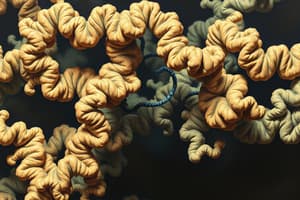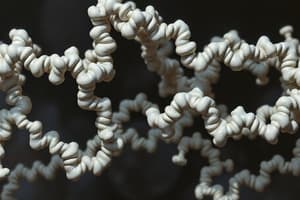Podcast
Questions and Answers
What are the functions of proteins in the body? (Select all that apply)
What are the functions of proteins in the body? (Select all that apply)
- Energy source (correct)
- Directly affecting gene expression
- Enzymes (correct)
- Building materials for growth (correct)
What are nonessential amino acids?
What are nonessential amino acids?
Amino acids that the body can synthesize from nitrogen and fragments of carbohydrates and lipids.
What causes protein denaturation?
What causes protein denaturation?
Heat, agitation, acid, base, alcohol, and heavy metals.
What is the role of pepsin in protein digestion?
What is the role of pepsin in protein digestion?
Match the following terms with their definitions:
Match the following terms with their definitions:
Protein provides energy only when carbohydrates are insufficient.
Protein provides energy only when carbohydrates are insufficient.
Which of the following is a high-quality protein source?
Which of the following is a high-quality protein source?
The liver releases ______ into the blood for excretion.
The liver releases ______ into the blood for excretion.
What is protein-energy malnutrition (PEM)?
What is protein-energy malnutrition (PEM)?
What determines the shape of a polypeptide chain?
What determines the shape of a polypeptide chain?
Flashcards are hidden until you start studying
Study Notes
Proteins Overview
- Proteins serve multiple functions in the body: growth support, enzyme production, hormone regulation, fluid balance, transport, immune defense, and as an energy source during gluconeogenesis.
Amino Acids
- Comprised of nonessential, essential, and conditionally essential types:
- Nonessential amino acids can be synthesized by the body.
- Essential amino acids must be obtained through diet.
- Conditionally essential amino acids become essential under stress or illness, such as Tyrosine in phenylketonuria (PKU).
Protein Structure
- Formation of proteins begins through condensation reactions forming dipeptides and polypeptides.
- The sequence of amino acids in a polypeptide determines its shape and consequently its function.
Protein Denaturation
- Denaturation alters a protein’s shape and therefore function, triggered by factors like heat, agitation, acid, base, alcohol, and heavy metals.
- Milk can act as an antidote to heavy metal poisoning.
Protein Digestion
- Starts in the mouth, continues in the stomach where hydrochloric acid denatures proteins and converts pepsinogen to pepsin.
- In the small intestine, proteins undergo hydrolysis facilitated by peptidase enzymes.
Amino Acid Transport and Absorption
- Amino acids are absorbed through secondary active transport driven by a sodium gradient and via facilitated diffusion.
Protein Synthesis
- DNA is transcribed to mRNA, which carries the amino acid sequence code to ribosomes for translation.
- Ribosomes synthesize proteins according to the mRNA instructions, utilizing transfer RNA (tRNA) for amino acid assembly.
Roles of Proteins
- Essential for growth and maintenance, serving as building blocks for body structures like collagen.
- Act as enzymes, hormones, and transporters regulating fluid balance and acid-base status.
- Functions include immune defense through antibodies and energy production during starvation.
Protein Metabolism
- Involves protein turnover with a consistent amino acid pool for production and energy use when nitrogen is removed.
- Nitrogen balance can be zero, positive, or negative indicating overall protein intake or deficiency.
Urea Excretion
- The liver converts excess nitrogen to urea, released into the bloodstream and filtered by the kidneys.
- Urea production is influenced by liver and kidney health as well as protein consumption and hydration.
Protein Quality
- Evaluated by quantity, daily values, and amino acid composition.
- High-quality proteins are typically animal-based; plant proteins may require combination for essential amino acids.
Protein-Energy Malnutrition (PEM)
- A condition caused by inadequate intake of proteins, energy, or both, representing a significant global malnutrition issue.
Considerations in Protein Research
- Focus on digestibility of proteins (animal vs. plant sources) and the importance of a complete amino acid composition to avoid nutritional deficiencies.
- The role of proteins in producing other compounds like neurotransmitters, melanin, and niacin.
Nutritional Guidelines
- Labels indicate protein content and quality, with special considerations for young children’s dietary needs and the necessity of adequate hydration during protein metabolism.
Studying That Suits You
Use AI to generate personalized quizzes and flashcards to suit your learning preferences.





